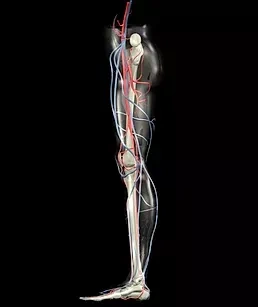Diagnosis

DUPLEX ULTRASOUND
What is a duplex ultrasound?
Duplex ultrasound is a non-invasive diagnostic procedure that combines traditional ultrasound imaging with Doppler ultrasound. This technique is used to assess blood flow within the blood vessels by using sound waves to create images and take measurements of blood flow. Healthcare professionals can observe blood flow and vessel responses through various maneuvers during the examination, providing immediate insights that guide clinical decisions.
What can a duplex ultrasound detect?
This diagnostic test can reveal potential issues and conditions that affect the arteries, such as blockages caused by atherosclerosis, blood clots, assess varicose veins, and monitor the health of arterial bypass grafts. A duplex ultrasound is especially beneficial for patients exhibiting symptoms of peripheral vascular disease, such as claudication or unusual sensations in the limbs. Those who show signs of deep vein thrombosis, like leg swelling or warmth, can benefit from a duplex scan to detect possible blood clots. Similarly, individuals with varicose veins or those with symptoms indicative of carotid artery disease, like transient ischemic attacks or minor strokes, can gain insights from this diagnostic tool.
Who is a good candidate for duplex ultrasound?
The procedure is useful for monitoring known aneurysms and assessing the risk of potential rupture. Hemodialysis patients with arteriovenous fistulas or grafts can have them evaluated for proper functioning. Patients who’ve undergone vascular surgeries can be periodically checked to ensure the effectiveness and health of surgical grafts. In cases of renal hypertension, the ultrasound can determine if there’s a reduction in blood flow to the kidneys. Moreover, the duplex ultrasound is especially useful when diagnosing conditions like deep vein thrombosis, evaluating the blood supply to tumors, and analyzing arterial health in cases of hypertension or organ transplantation.
What type of result can I get from this test?
Duplex ultrasounds provide essential insights into vascular health without exposure to ionizing radiation, making this diagnostic test a preferred choice for a wide range of vascular conditions. This test offers a comprehensive view of the vascular system by visualizing the anatomy of blood vessels and assessing the dynamics of blood flow. Its dual capacity allows healthcare professionals to detect a variety of vascular conditions, from blockages and blood clots to inefficient blood flow caused by varicose veins.
Another notable advantage is its non-invasive nature. Unlike some diagnostic methods that require incisions, injections, or the insertion of instruments, duplex ultrasound uses sound waves, making the procedure relatively painless and devoid of direct risks associated with surgical interventions or the introduction of contrast agents.

Arteriogram
What is an Arteriogram?
The arteriogram, also known as an angiogram, is a medical imaging test used to visualize and examine arteries in the heart, brain, kidneys, and other parts of the body. It involves the injection of a contrast dye into the bloodstream, followed by the use of X-ray or fluoroscopy imaging to capture real-time images of blood flow through the arteries.
What type of diseases can an Arteriogram detect?
This diagnostic test is used to detect various diseases and conditions that affect the arteries, including atherosclerosis, coronary artery disease, cerebrovascular diseases, peripheral artery disease (PAD), renal artery stenosis, and more.
Who is a good candidate for an Arteriogram?
Good candidates for arteriogram are people who have symptoms or risk factors that suggest various arterial diseases. This may include individuals with chest pain, patients with heart disease, people who experience leg pain during exercise, and individuals exhibiting stroke or transient ischemic attack (TIA) symptoms.
How do I get my results?
An arteriogram provides detailed information on the state of specific arteries, which allows your physician to better diagnose and treat your condition. This procedure can identify blockages, pinpoint narrowing or occluded arteries, detect aneurysms, reveal arteriovenous malformations (AVMs), help diagnose peripheral artery disease, as well as identify stenosis or blockages that contribute to cerebrovascular diseases like stroke or TIA.
This information is crucial for making accurate diagnoses and determining appropriate treatments that are tailored to each patient. The arteriogram plays a vital role in enhancing patient care and improving outcomes. With its ability to provide detailed images and insights into the arterial system, the arteriogram procedure continues to be an invaluable tool in the field of cardiovascular and interventional medicine.
